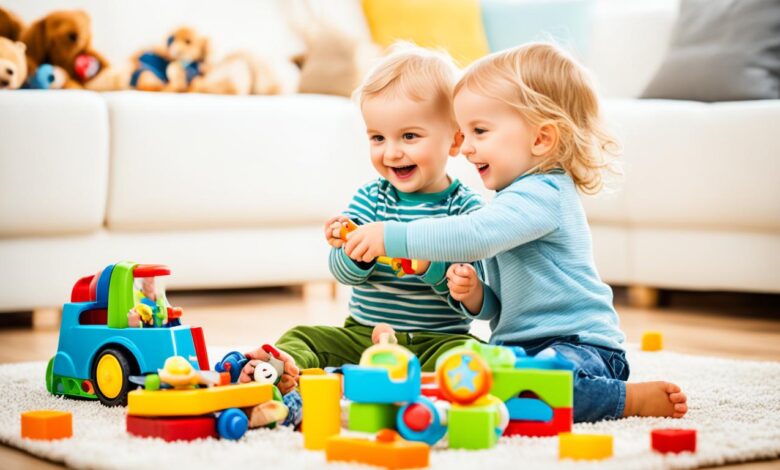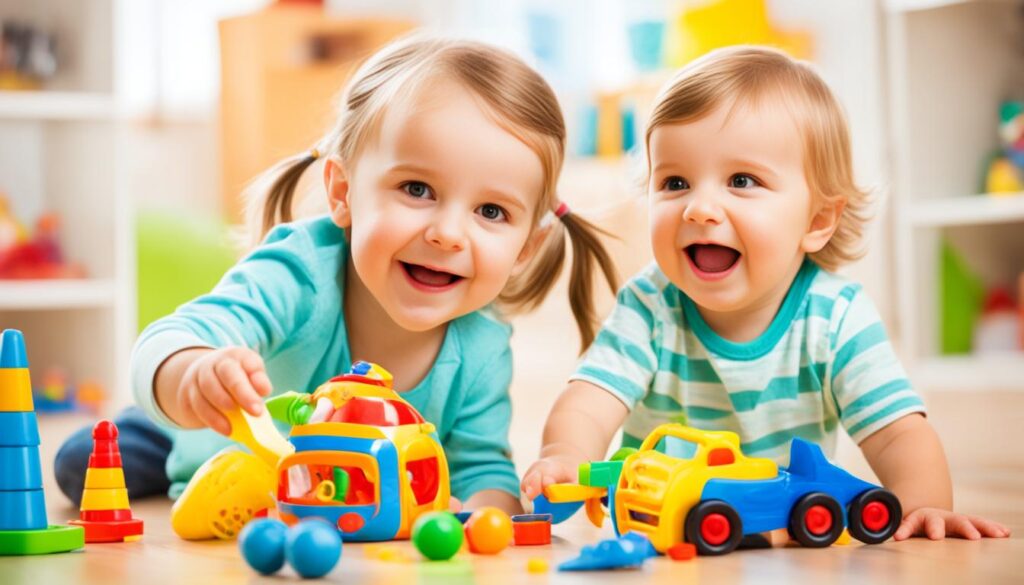
The sound of kids arguing over toys can be really frustrating for parents. It’s a common sight: toys all over the floor, laughter turning to tears as kids fight for the same toy. We all wish for a simple way to stop kids from fighting over toys. We want to make sharing easy and natural for them.
Learning how to stop kids from fighting can make playtime much better. It’s not just about the toys. It’s about teaching kids to be kind and respect each other. Let’s look at ways to make playtime more cooperative and peaceful for everyone.
Key Takeaways
- Recognizing the commonality of toy disputes can help in addressing them effectively.
- Understanding child development stages aids in guiding sharing behaviors.
- Creating a sharing-friendly environment is crucial for reducing conflicts.
- Establishing clear rules fosters consistency in learning how to share.
- Modeling positive sharing behavior sets a strong example for children.
- Using visual reminders can effectively encourage sharing among siblings.
Understanding the Psychology of Sharing
Understanding why kids share or don’t share can really help parents. Kids go through different stages that affect how they share. Knowing these stages helps parents use the right sibling conflict resolution strategies to encourage sharing.
The Stages of Child Development and Sharing
Sharing starts early in childhood. Babies mainly think about their own needs and don’t really understand sharing. Toddlers start to play near others but still find it hard to share. By preschool, kids get better at understanding others and the value of sharing.
This knowledge lets parents use the best kids’ toy sharing tactics to help kids play together well.
Importance of Empathy in Toy Sharing
Empathy is key for kids to share with each other. As kids get better at understanding others’ feelings, they learn to share more. This stops fights over toys and makes playtime better for everyone.
Teaching kids to empathize not only makes them better sharers. It also helps them make stronger friends and improves their social skills.
Setting the Stage for Successful Sharing
Creating a calm space for kids to share toys is key to peaceful play. When kids feel at ease and engaged, they’re more likely to share. The setup of play areas greatly helps in reducing fights over toys.
Creating a Sharing-Friendly Play Environment
Starting with a plan is the first step to a sharing-friendly space. Parents can set up play areas that let kids interact without feeling swamped. Using a toy rotation scheme is also smart, limiting toys at a time. This makes kids appreciate what they have and less likely to fight over toys.
The Role of Space and Organization
Being organized is crucial for playtime. Setting up different areas for building, art, and group play helps kids know where things go. This cuts down on confusion and fights. An organized space also makes it easier for kids to switch activities and work together.
| Play Area Type | Purpose | Benefits |
|---|---|---|
| Individual Play Area | Encourage personal creativity | Reduces toy disagreements |
| Group Play Area | Foster teamwork and sharing | Promotes cooperation |
| Rotating Toy Shelf | Limit available toys | Increases interest and sharing |
Working to make play areas organized and friendly helps cut down on toy fights. It also encourages kids to work together and share. This builds habits of cooperation and kindness during play.
Establishing Clear Rules and Expectations
Clear rules help prevent fights over toys. Kids like knowing what to do and what’s expected. Having clear sharing rules can stop fights and encourage sharing.
The Power of Consistency in Guiding Behavior
Being consistent helps teach kids about sharing. Regular routines make things clear and stable. By always saying sharing is important, parents teach kids to cooperate.
Kids learn by doing things over and over. So, always telling them to share shows them it’s good. This helps them understand sharing is positive.
Using Visual Reminders to Encourage Sharing
Visual reminders work well for sharing. Charts or pictures of sharing rules help kids remember. For example, a chart with toys and how to share them can catch their eye.
Seeing these reminders helps kids remember to share. This cuts down on fights and encourages sharing.

Teaching the Art of Sharing
Parents are key in teaching their kids about sharing. By sharing things during family time, they show what it means to share. This helps kids learn the value of sharing and its benefits.
When parents praise their kids for sharing, it encourages them to do it more. This leads to better relationships between siblings.
Modeling Sharing Behaviors as Parents
Parents should show kids how to share by doing it themselves. Sharing things with each other or with their kids shows positive ways to interact. This helps kids learn how to solve conflicts and work together.
Talking about sharing with kids helps them understand its importance. It gives them a strong base for knowing why sharing is important.
Stories and Examples to Share with Children
Stories can make sharing more interesting for kids. Use stories that show how sharing helps friends and communities. These stories touch kids’ hearts and help them see the value of empathy.
Stories teach kids about sharing and motivate them to live by these values. This makes their relationships with others better.
FAQ
How can I put an end to kids fighting over toys?
Setting clear rules about sharing and organizing playtime can help. Encourage kids to play together and show them how to share by being a good example.
What are some effective sibling conflict resolution strategies?
Talk about feelings to help kids understand sharing better. Use structured playtime to teach them about sharing. Make sure there are areas for everyone to play together with clear rules.
How can I create a peaceful playtime environment?
Start by organizing toys and using a rotation to limit what’s available. Make sure there’s a mix of toys for playing alone and together. This can help reduce fights over toys.
Why is empathy important in toy sharing?
Empathy helps create a respectful and cooperative environment. When kids understand others’ feelings, they’re less likely to fight over toys.
How can visual reminders encourage sharing?
Charts can remind kids of the rules about sharing. Setting specific times for sharing makes it clear what’s expected. This encourages kids to share more.
What are some kids’ toy sharing tactics parents can teach?
Parents should model sharing themselves and teach kids about taking turns. Sharing stories can also make sharing fun and positive.
How do I minimize conflicts during playtime?
It’s important to have clear routines and expectations. Structured sharing sessions and visual reminders can make playtime more predictable. This can help reduce fights among kids.




